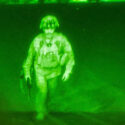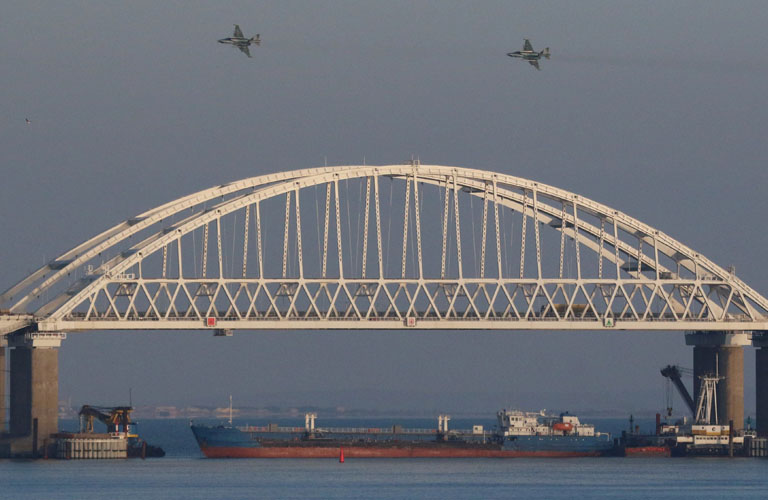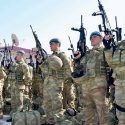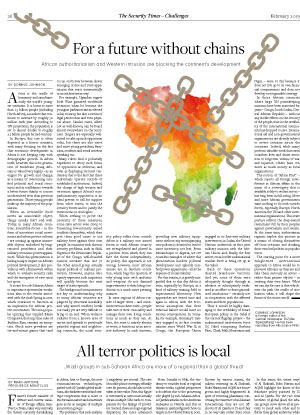All terror politics is local: Jihadi groups in sub-Saharan Africa are more of a regional than a global threat
France’s former minister of defense and current minister of foreign affairs, Jean-Yves Le Drian, takes very seriously the threats currently destabilizing the Sahel, especially since the intervention in Mali by French troops in January 2013. He co-organizes the annual Dakar International Forum on Peace and Security in Africa. At the most recent forum, on Nov. 6, 2018, he declared: “Cybersecurity is a priority in the fight against terrorism.”
This echoed the worries of many analysts in Europe, America and the Middle East who have noted how the internet has permitted terrorist networks to raise funds, indoctrinate new recruits, train “martyrs” and plan attacks by gathering and sharing information on their targets. Those experts who believe in the transnational and interconnected character of the various jihadi movements around the world thus insist on the global dimension of the ideology of Al Qaeda and its successors. In their view, as well as serving to disseminate revolutionary models and combat techniques that could inspire terrorist networks in Africa, Asia or Europe, the new communications technologies, paired with Al Qaeda’s global ambitions, also facilitate tactical and strategic cooperation that is more or less formal in nature and sometimes goes as far as mergers of multiple insurrection groups.
The problem is that such analyses hardly correspond to the reality on the ground in the countries of sub-Saharan Africa where jihadi groups are active: essentially, Al Shabaab in the Horn of Africa, Boko Haram around Lake Chad and the nebulous Al Qaeda in the Islamic Maghreb (AQMI) in Mali and westward.
As the available studies show, these insurrection groups recruit not through the internet, but rather via clan solidarity by forging matrimonial alliances and by offering their protection to communities stigmatized by the security forces. Moreover, the zones affected by conflict are often among the world’s least connected.
Africa’s most populous country, Nigeria, where Boko Haram was founded, is rather typical in this respect. According to official statistics for 2017, 51 percent of the population has internet access. In practice, however, less than 10 percent are capable of participating in social media, and bit rates are below 3 megabytes per second. The rate of mobile phone coverage, officially over 80 percent, should also not be taken at face value. First, this figure is overstated, as users must actually obtain multiple SIM cards to compensate for the failings of providers. Second, there are huge regional disparities; the more urbanized south has far better coverage than the rural and Muslim regions in the north, where Boko Haram operates.
In its way, then, the question of the role of the internet in the production and diffusion of movements described as terrorist (rather than as insurrections) illustrates the erroneous and stereotyped representations that exist concerning the state of jihadi forces in sub-Saharan Africa. Out of ignorance of the reality on the ground, many observers imagine that, being poor, Africans are easily manipulated and susceptible to the most extreme forms of religious fanaticism. However, these same observers tend to see the jihadi movements in the Sahel as an extension of the conflicting dynamics in the Arab world, even if this means according exaggerated importance to the allegiance to Al Qaeda sworn by Al Shabaab and AQMI, or that sworn by one faction within Boko Haram to the Islamic State.
From Somalia to Mali, the tendency to consider local or regional threats within a global perspective is doubtless due to the pioneering role played by sub-Saharan Africa. Al Qaeda’s attacks on the American embassies in Nairobi and Dar es Salaam in 1998 prefigured those on targets in the United States in 2001. Moreover, the setbacks currently being suffered by IS in Iraq and Syria are giving rise to fears that Islamic State combatants may try to seek refuge south of the Sahara.
It is worth bearing in mind, however, that beyond the alignment of their communications policies, the global connections of the jihadists of the Sahel are very limited, particularly in operational terms. Al Shabaab is the only group with a genuine overseas network via the Somali diaspora; several secondgeneration migrants have returned to the Horn of Africa to commit attacks. Unlike the Islamic State (IS), the nebulous forces of Boko Haram and AQMI have little appeal for prospective jihadists coming from Europe, America or the Arab world. Their recruiting structures are very local and focused on areas with porous borders.
Moreover, unlike IS and Al Qaeda, none of these groups have mounted any attacks overseas. Known by various names, the milieus centering on Al Shabaab, Boko Haram and AQMI are homegrown and highly fragmented. In spite of recurring phantasms concerning the existence of an Islamist International, they are not offshoots of Al Qaeda or IS and they in no way take orders from some hypothetical central command that supposedly coordinates their attacks from southern Libya. Similarly, inside a country like Mali, it would be mistaken to see the Katiba (Islamist fighting units) of the central Macina region as a simple extension of the Tuareg rebellions being conducted further north.
In this light, it is important to relativize the significance of allegiances to IS or Al Qaeda. Depending on the needs of the hour, sub-Saharans, too, are entirely capable of manipulating the Arabs. As admitted by an internal IS document, the leader of the “original” Boko Haram, Abubakar Shekau, declared allegiance to IS in 2015 to stay in power, crush his opponents and confront the antiterrorist coalition recently marshaled against him by the armies of Nigeria, Niger, Chad and Cameroon. In practice, the armed gangs that continue to operate around Lake Chad are completely at odds with “jihadi orthodoxy.”
In this sense, the errant ways of Al Shabaab, Boko Haram and AQMI highlight the limits of the franchise policy pursued by IS and Al Qaeda. For the two rival brothers of global jihad, the African groups serve above all as pretexts to insult each other and to flatter their global ambitions while engaging in a kind of war of communiqués. In recent months, both have repudiated Abubakar Shekau, who is unanimously condemned for his tendency to excommunicate (takfir) and kill Muslims.
In fact, the African forms of jihad have proved to differ widely from the model proclaimed by Osama bin Laden – hence the need to understand the conflicts in Somalia, Mali and Nigeria less in global terms and more in terms of local dynamics.
MARC-ANTOINE PÉROUSE DE MONTCLOS
is a political scientist and senior researcher at the Institut de recherche pour le développement (IRD) in Paris, editor in chief of Afrique Contemporaine and author of L’Afrique, nouvelle frontière du djihad? (Africa, the new frontier for the jihad?) published by La Découverte in 2018.




